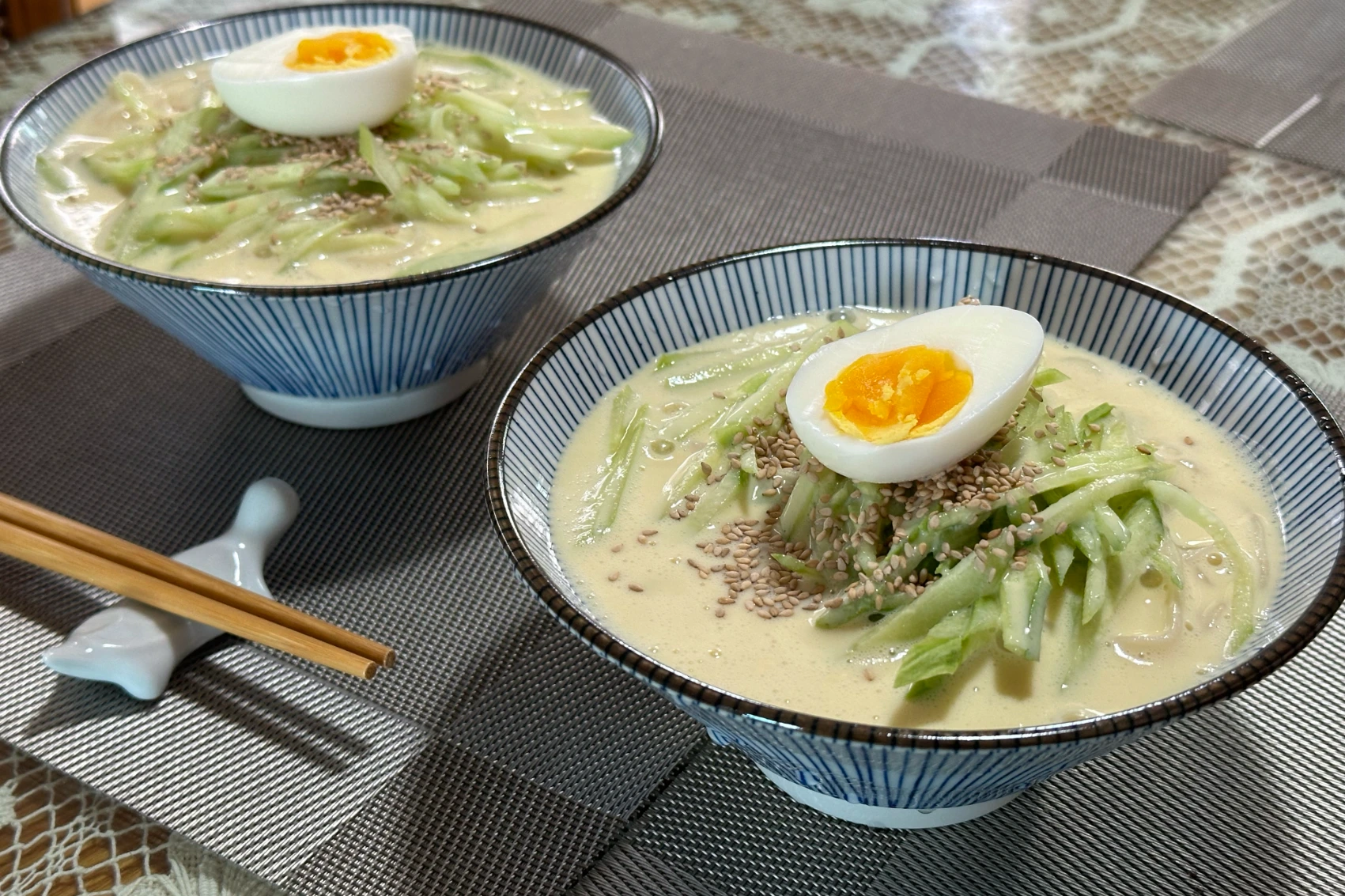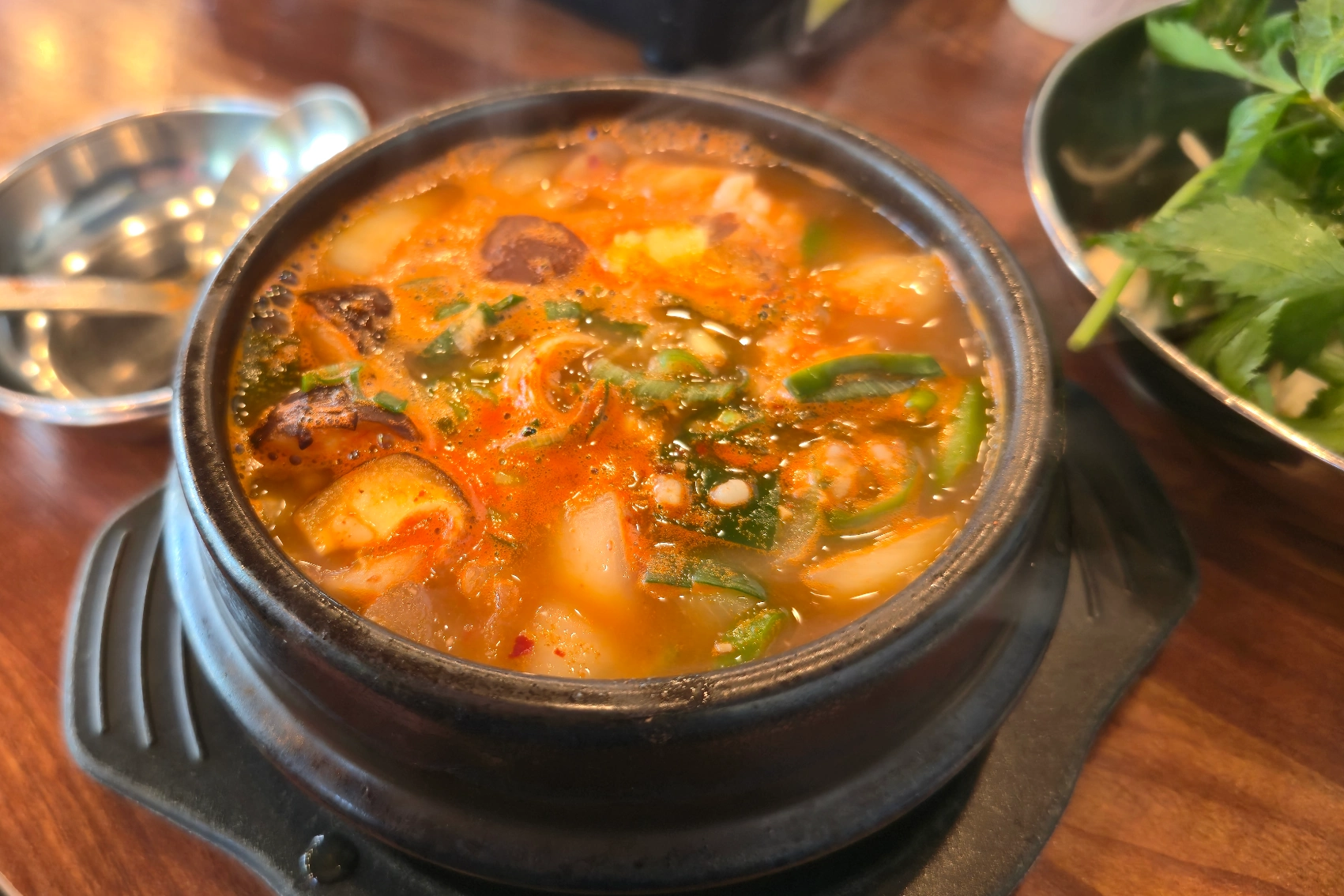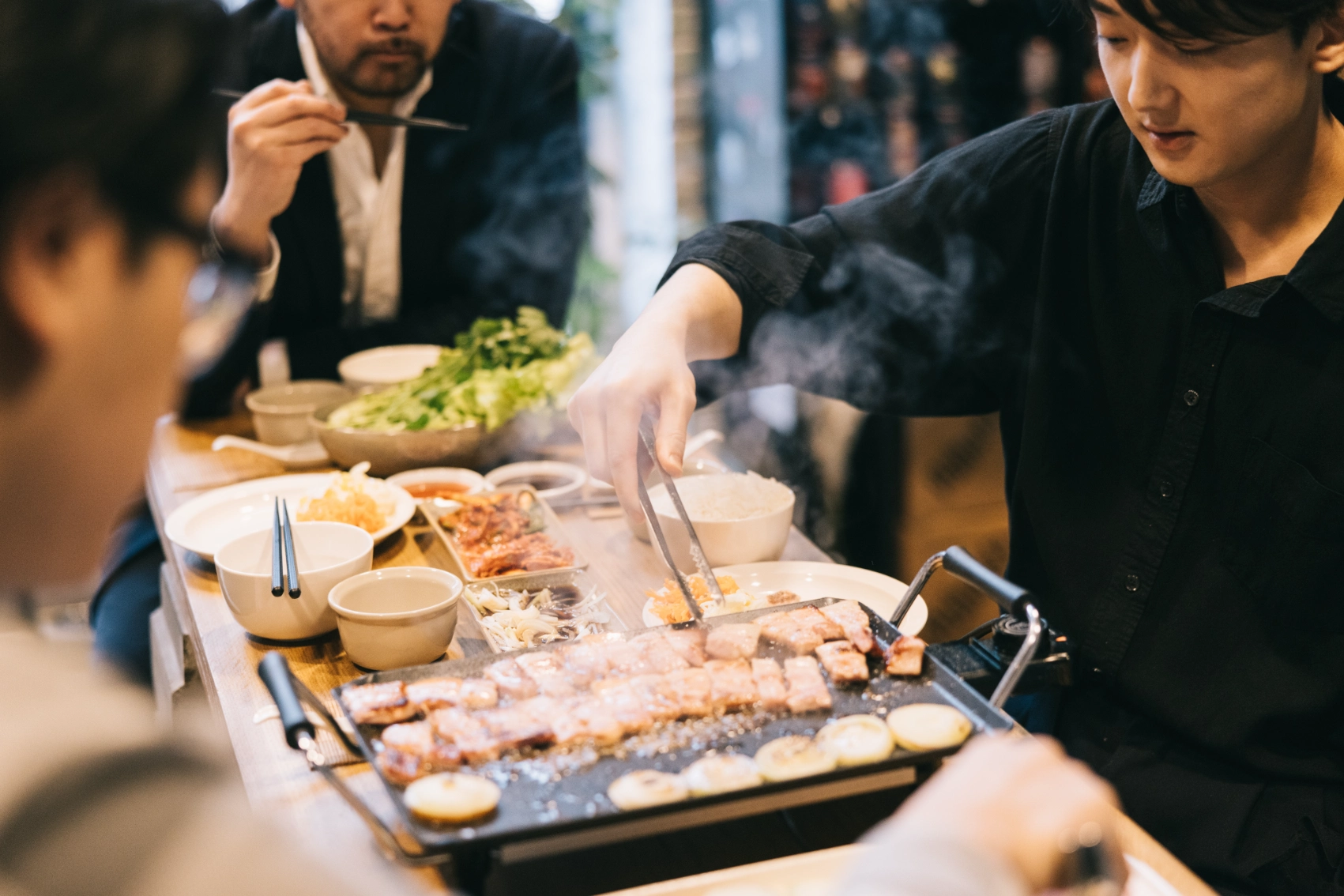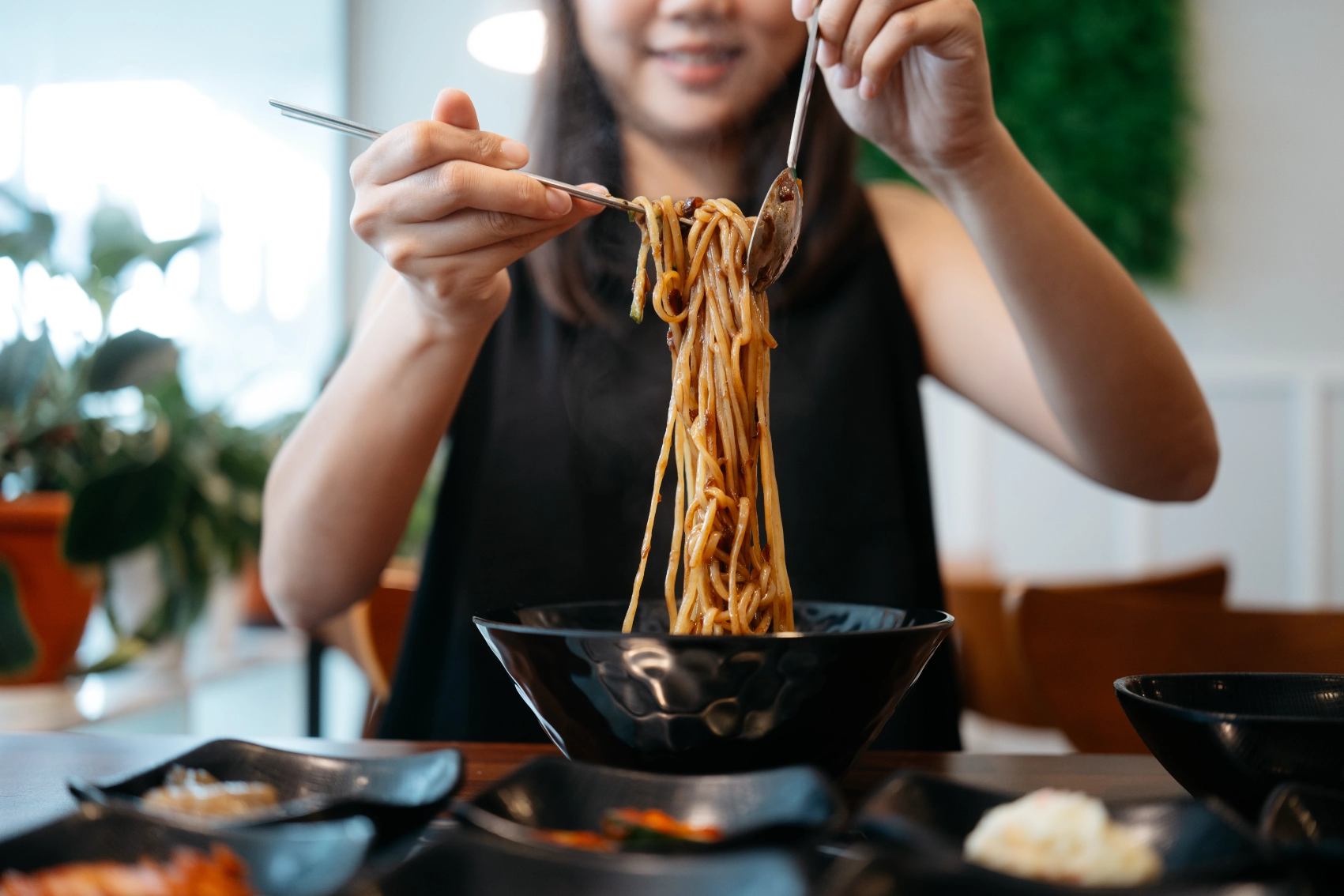Whether you’re eating black noodles or downing a whole chicken to renew the soul, food in South Korea is full of smoky, sweet flavours like nowhere else on this planet. To help you navigate the mouthwatering world of Korean food menus, we’ve designed a starter kit to help you understand some of the most popular dishes in South Korean cuisine. We recommend beginning with soups and sides, moving on to the meat and noodle dishes, and then finishing with a shot of soju. Cheers!
Korean soups
Kongguksu
Korea is no stranger to a cold soup. No, it’s not a comment on the slow service — the waiters are very attentive. It’s a cooking style they’ve perfected. Kongguksu is a cold soy milk noodle soup. "Milk soup?!" you exclaim. Well, what is milk but a cold soup? Add noodles, fresh soybeans, and a sesame seed garnish, and you’ve got yourself a rich, nutty ice-cold broth perfect for a hot summer’s day.

Taste it for yourself on: Best of South Korea
Tteokguk
Known as Korean New Year soup, tteokguk is a light but filling dish made with a beefy broth and thinly sliced rice cakes. How they keep the rice cakes from getting soggy is one of life’s great mysteries. It’s traditionally made for the Lunar New Year because it’s said to bring health and prosperity. In fact, it is believed that eating this soup adds a year to your age. If you don’t care about personal growth, then maybe give this dish a miss and stay young forever.
Doenjang jjigae
Jjigae is a thick Korean stew usually made with a choice of meat, seafood, or vegetables and seasoned with a hot pepper paste, fermented miso, and soybean paste. There are different varieties, but doenjang is the most iconic soybean stew and typically uses dried anchovies, white radish, potato, zucchini, and tofu. Many choose to add clams, prawns, or beef to give it a bit more heartiness.

Taste it for yourself on: South Korea Explorer
Samgyetang
Samgyetang is essentially chicken soup, but not quite as you know it. Order samgyetang and you’ll get a bowl of soup with an entire chicken submerged in its frothy ginseng depths. Not unusual enough? Koreans typically eat this piping hot bowl of soup in the summer because they believe it renews the body’s energy. Prepare to get sweaty and bring some cold towels.
Taste it for yourself on: Essential Korea
Korean snacks and sides
Kimchi
Koreans have more than 100 types of kimchi. It’s the spicy staple on every Korean table. Typically made from fermented cabbage, carrots, and radishes and mixed with chilli, ginger, garlic, and green onions, kimchi, even the milder kinds, pack a punch. Kimchi is often served on the side, but it’s also gorge-able on its own or with white rice. The fermented snack goes back 2,000 years, but if you suspect the kimchi on your plate is from the Silla dynasty, please notify your server.
As well as a superstar side dish, kimchi is also used in stews. For example, kimchi jjigae is tofu, pork, and vegetables cooked in sautéed kimchi. There are also kimchi pancakes called kimchi jeon and kimchi fried rice. Needless to say, it is all delicious.

Taste it for yourself on: Korea & Japan Encompassed
Gimbap
Sushi-like in appearance, gimbap, also known as kimbap, is a seaweed-wrapped parcel of ground beef, sautéed vegetables, sweet pickled radish, and rice. Prized for its portability, gimbap is a popular on-the-go food and often makes an appearance at picnics and outdoor events. It has lots of varieties, but we recommend mayak gimbap, which translates as "drug seaweed rice" — it’s dangerously addictive.
Taste it for yourself on: China and South Korea: East Asia Adventure
Ppeongtwigi
Ppeongtwigi, made from popped grains, is a common street food snack in Korea. It’s not hugely exciting, but it fills the gap when you’re out and about and need a top-up. It’s also fun to say, the onomatopoeic pronunciation mimicking the sound of the grains in the popping machine. Place your order with any curb-side vendor for a local dining experience.
Korean meat dishes
Korean fried chicken
The colonel won’t like this, but Korean fried chicken is finger-licking good. It’s more than a hangover staple; it's earned its place on the lunch table. The sweet and spicy batter is uniquely Korean and popular with locals and travellers alike. There’s even a word for chicken and beer: chimaek. Why overcomplicate the ordering process when you just need two syllables?
Taste it for yourself on: Journeys: Soul of South Korea
Korean barbecue
Perfect for fussy eaters, Korean barbecues bring the grill to you and let you cook the meat however you want from the comfort of your dining table. Choose from a range of different cuts and marinades. Bulgogi (marinated sirloin) is one of the most popular, but galbi (marinated beef rib) is also a local favourite. If you don’t want to cook, some Korean barbecue restaurants have a chef and a hotplate built into the table. Just open your mouth and they’ll pop the meat right in.

Taste it for yourself on: Uncover Korea: K Pop & Hanok Villages
Bulgogi
Arguably the main event of any Korean barbecue, bulgogi is a sweet meat dish made of thin, marinated slices of meat, most commonly beef. The smoky-sweet marinade is typically a mix of soy sauce, honey, sesame oil, garlic, onion, and a spicy paste. The dish is then served on a side of leafy vegetables, spicy soybean paste, and kimchi. Bulgogi has been doing the rounds for more than 1,000 years but is only now blowing up around the world — proof that the best things in life are slow burners.
Taste it for yourself on: Solo-ish South Korea
Korean rice and noodle dishes
Bibimbap
If you know one Korean dish, it’s probably going to be bibimbap. It’s a fast-food favourite. Cheap and cheerful, it’s the go-to for time-strapped workers. The bowl often consists of a simple salad, rice, vegetables, chicken or beef, and an egg. There’s also a variation called hoedeopbap, which swaps the meat for raw seafood, such as salmon, tuna, or octopus. Once a snack served to the king, it is now devoured by hungry hordes far and wide.
Taste it for yourself on: Korea to Japan: Epic Eats & Bright City Lights
Jjajangmyeon
Jjajangmyeon is thin Chinese-style noodles made juicy and fat for ultimate indulgence. Some Koreans live off this dish. The wheat noodles are topped with raw cucumber, black soybean paste, diced pork, and a selection of vegetables. It’s not much to look at, but it’s rich, hearty, and often cheap. It’s said that people who don’t receive gifts on Valentine’s Day often get together, put on their blackest clothes, and gorge on black-coloured food like jjajangmyeon.

Japchae
Japchae is one of the most popular dishes in Korea, and it’s easy to see why. Sweet noodles covered in sesame and soy are mixed with stir-fried meat and vegetables. It might sound easy to prepare, but there’s an art to getting everything cooked perfectly. Once you’ve had sweet potato noodles, it’s hard to think of anything else.
Taste it for yourself on: Seoul to Osaka: Beaches & Big Cities
Korean drinks
You’ve ordered your food, and the server is staring at you expectantly, waiting for you to order a drink. What will you choose? Fear not, we’ve prepared a short pairing menu.
Soju
Traditionally made from rice, soju is one of the most popular drinks in Korea. The flavour is similar to vodka, and it is often served neat. The lightness of soju means it is often paired with heavier meals like stews, as well as grilled meats and fried dishes. Order it with your jjigae and you can’t go wrong.

Makgeolli
If you’re sitting at a Korean barbecue, the likelihood is that tables around you will all feature a bottle or two of makgeolli. It's a milky rice wine with a sweet, tangy flavour. It’s less alcoholic than most wines, but its drinkability can catch you off guard, so drink responsibly.
Korean green tea
Green tea is widely considered to be a superdrink, with an impressive résumé of health benefits. It tastes good no matter the occasion, but it goes particularly well with a serving of rice cakes.
Bokbunja
Bokbunja, traditionally made from fermented black raspberries, is a Korean fruit wine widely believed to promote beauty. You can drink it anytime you need perking up, but don’t pair it with anything too rich because the flavours will compete. Salads and salty snacks go well.























